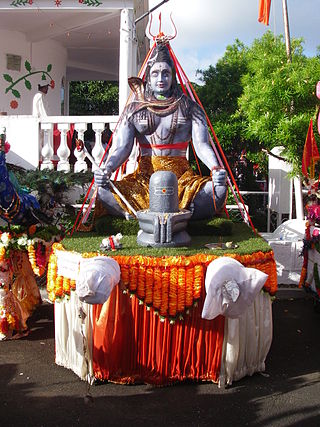
Maha Shivaratri is a Hindu festival celebrated annually in honour of the deity Shiva, between February and March. According to the Hindu calendar, the festival is observed on the fourteenth day of the first half of the lunar month of Phalguna. The festival commemorates the wedding of Shiva and Parvati, and the occasion that Shiva performs his divine dance, called the Tandava.
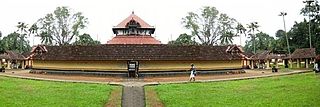
Kaduthuruthy is a town in Kottayam District in the state of Kerala, India.

The Halesi-Maratika Caves are located next to the village of Mahadevasthan, in the Khotang District of eastern Nepal, 3,100 ft. – 4,734 ft. above sea level. The cave and temple are about 185 km south west of Mount Everest. The temple is a venerated pilgrimage site for Hindus, Buddhists and Kirat. The caves are called the Halesi Mahadev Temple by Hindus who associate them with Mahadeva, a form of Shiva; while they are known as the sacred place to Buddhists, who consider them to be the caves associated with the legend of Padmasambhava. The Kirati Rai of the region worship Halesi as an ancestral deity of the community. The Kirat mundhum, a rich oral tradition of the Kirats, manifests that their ancestor Raechhakule (Khokchilipa) also known as Hetchhakuppa used to stay inside the Halesi cave in the remote past. For that reason, the Kirat/Rais consider Halesi as their ancestral place.

Murdeshwar is a town in Uttara Kannada district in the state of Karnataka, India, and lies on the coast of the Laccadive Sea. It contains the world's third tallest Shiva statue, as well as the Murudeshwara Temple. The town has a railway station on the Mangalore–Mumbai Konkan railway route.
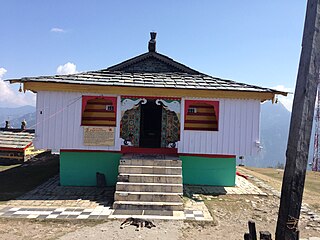
Bijali Mahadeva Mandir is a located in Kashawri village, Kullu Valley in the Indian state of Himachal Pradesh. It is located at an altitude of about 2,460m in the Kullu Valley. Bijli Mahadev is one of the ancient temples in India and dedicated to Lord Shiva (Mahadev). Located 14 km from Kullu across the Beas river, it can be approached by a rewarding trek of 3 km.
Sunaguthi is a small town located about 4 km (2.5 mi) south of the main Lalitpur city in Lalitpur District. According to 2011 Nepal census, Sunaguthi has a population of 10,092 living in 2397 individual households. Most of the people living in Sunaguthi are Newar. The offshoot road near the Satdobato segment of the Ring Road leads to Sunaguthi. This road ultimately leads to Lele and is referred to as Laxmi Prasad Devkota Marga .Thecho is situated on the southern part of Sunaguthi, Bungamati and Bhaisipati on west, Dhapakhel on east and Khumaltar and Nakhipot on North. The famous jatras of sunaguthi are yomari punhi, gathamuga,bhimsen jatra, chakha jatra, pekha jatra, etc.

Mahadeva Temple, Tambdi Surla is a 13th-century Hindu temple in the Kadamba style dedicated to Lord Shiva, one of the main deities in Hinduism, and is an active place of Hindu worship. It is an ASI protected Monument of National Importance in Goa. The temple is dedicated to Lord Shiva and is reminiscent of the temples at Aihole in neighbouring Karnataka.
Lodheshwar Mahadev Temple is a Hindu temple of Shiva, located in village Mahadeva, Ram Nagar tehsil in Barabanki district, Uttar Pradesh,India. The deity of Shivling worshiped in this temple is one of the rarest of the 52 Shivlings found on the Shakti Pithas across India. This ancient temple has been mentioned several times in Mahabharat. Lodheshwar Mahadev is Kuldevta of Lodhi Rajputs. Its importance has been mentioned in many Hindu scriptures and holy books. This shakti peetha is considered to be one of the most sacred places on earth.

Doleshwor Mahadeva is a Hindu Temple of Lord Shiva located in Suryabinayak, south eastern part of Bhaktapur District, Nepal, and is believed to be the head part of Kedarnath temple located in Uttarakhand, India.

A lingam, sometimes referred to as linga or Shiva linga, is an abstract or aniconic representation of the Hindu god Shiva in Shaivism. The word lingam is found in the Upanishads and epic literature, where it means a "mark, sign, emblem, characteristic," the "evidence, proof, symptom" of God and God's power.
Dhaneshwor Temple(Nepali: धनेश्वर मन्दिर) is located between the Banepa and Panauti. It lies in the 1 km south of the Banepa Bazaar.This is a temple of Shiva.
Kageshwori is a religious place in Kageshwori Manahara Municipality-1, located north-east of Kathmandu, capital city of Nepal. The god Shiva is the attraction of the believers. It is one of the 64 Shivalingas mentioned in the Linga purana. The temple was established in the Licchavi period.

A mukhalinga or mukhalingam is a lingam represented with one or more human faces in Hindu iconography. A lingam is an aniconic representation of the Hindu god Shiva. Mukhalingas may be of stone or can be made of a metal sheath, which covers the normal lingam.
The Achaleshwar Mahadev Temple is a Shiva temple situated just outside the Achalgarh Fort, located in the Abu Road tehsil of Sirohi district, in the western Indian state of Rajasthan. The temple is believed to have been constructed sometime in the 9th century AD, and by the Paramara dynasty, which is also credited with having constructed the original structure of the Achalgarh Fort, later reconstructed, renovated and named as Achalgarh by Maharana Kumbha in 1452 CE.
Bagdana is a village in Mahuva Taluka of Bhavnagar district, Gujarat, India.
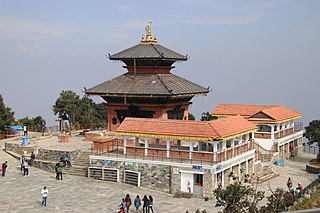
Bhaleshwor Mahadev is a Hindu temple located in Chandragiri hill in south-west side of Kathmandu Valley. It is dedicated to Lord Shiva. It is located at the altitude of 2551 meters above sea level. The temple was built by Chandragiri Hills on the historic and religious site. The temple was designed by the architect Shankar Nath Rimal. The temple is connected to the Kathmandu valley by a cable car.

Tadkeshwar Mahadev temple is a Hindu temple. It is located near Abrama town in Valsad district of the Indian state of Gujarat. The temple is on the bank of the Wanki river.
Gangeshwar Mahadev Temple or simply Gangeshwar Temple is a Hindu temple dedicated to Lord Shiva (Mahadeva) located at seashore of Fudam village just 3 km away from Diu in the union territory of DNDD. The view of the temple is unique set on the Arabian Sea. This is basically a cave temple situated in the midst of the rocks on the seashore. Once pilgrims enter the cave Lord Ganesha, Lord Vishnu, and Goddess Lakshmi can be sight then five shivalingas could visible in different sizes in middle of the sea water, this is the very significant feature of the temple and above the rock the Shiva Linga Seshanag was carved to look out for the Shiva Linga. These lingas are generally submerged in the sea during high tides and only during the low tides chance to visible. This temple is also known as 'Seashore Temple' as Shiva Linga is situated on the seashore.
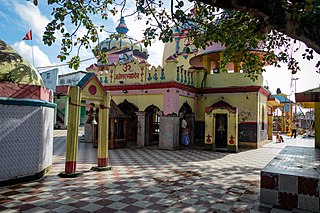
Jaleshwar Mahadev Temple is a hindu temple of Shiva situated at Mahottari district, Nepal. Pilgrims visit this temple on Maha Shivaratri and Vasant Panchami. The city of Jaleshwar where this temple is located is named after this temple.
Ekadash Rudra Mahadev Mandir is a Hindu temple dedicated to Lord Shiva at Mangrauni village of Madhubani district in the Mithila region of Bihar, India.













